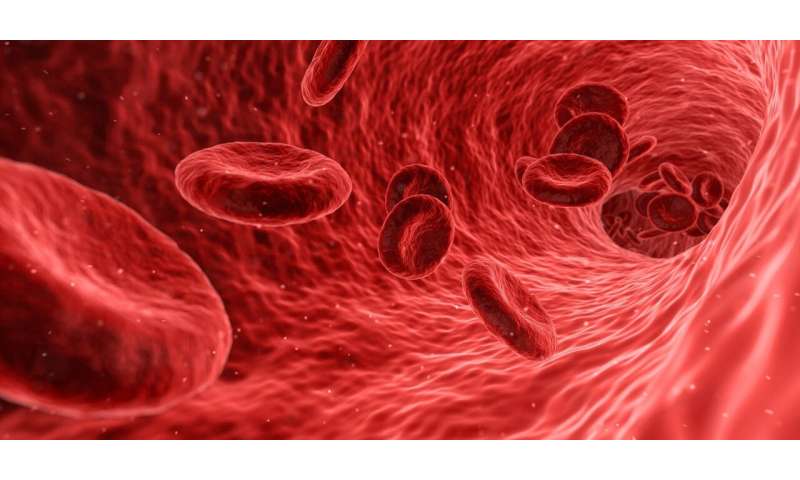Home » Health News »
Mapping out the mystery of blood stem cells

Princess Margaret scientists have revealed how stem cells are able to generate new blood cells throughout our life by looking at vast, uncharted regions of our genetic material that hold important clues to subtle biological changes in these cells.
The finding, obtained from studying normal blood, can be used to enhance methods for stem cell transplantation, and may also shed light into processes that occur in cancer cells that allow them to survive chemotherapy and relapse into cancer growth many years after treatment.
Using state-of-the art sequencing technology to perform genome-wide profiling of the epigenetic landscape of human stem cells, the research revealed important information about how genes are regulated through the three-dimensional folding of chromatin.
Chromatin is composed of DNA and proteins, the latter which package DNA into compact structures, and is found in the nucleus of cells. Changes in chromatin structure are linked to DNA replication, repair and gene expression (turning genes on or off).
The research by Princess Margaret Cancer Centre Senior Scientists Drs. Mathieu Lupien and John Dick is published in Cell Stem Cell, Wednesday, November 25, 2020.
“We don’t have a comprehensive view of what makes a stem cell function in a specific way or what makes it tick,” says Dr. Dick, who is also a Professor in the Department of Molecular Genetics, University of Toronto.
“Stem cells are normally dormant but they need to occasionally become activated to keep the blood system going. Understanding this transition into activation is key to be able to harness the power of stem cells for therapy, but also to understand how malignant cells change this balance.
“Stem cells are powerful, potent and rare. But it’s a knife’s edge as to whether they get activated to replenish new blood cells on demand, or go rogue to divide rapidly and develop mutations, or lie dormant quietly, in a pristine state.”
Understanding what turns that knife’s edge into these various stem cell states has perplexed scientists for decades. Now, with this research, we have a better understanding of what defines a stem cell and makes it function in a particular way.
“We are exploring uncharted territory,” says Dr. Mathieu Lupien, who is also an Associate Professor in the Department of Medical Biophysics, University of Toronto. “We had to look into the origami of the genome of cells to understand why some can self-renew throughout our life while others lose that ability. We had to look beyond what genetics alone can tell us.”
In this research, scientists focused on the often overlooked noncoding regions of the genome: vast stretches of DNA that are free of genes (i.e. that do not code for proteins), but nonetheless harbor important regulatory elements that determine if genes are turned on or off.
Hidden amongst this noncoding DNA—which comprise about 98% of the genome—are crucial elements that not only control the activity of thousands of genes, but also play a role in many diseases.
The researchers examined two distinct human hematopoietic stem cells or immature cells that go through several steps in order to develop into different types of blood cells, such as white or red blood cells, or platelets.
They looked at long-term hematopoietic stem cells (HSCs) and short-term HSCs found in the bone marrow of humans. The researchers wanted to map out the cellular machinery involved in the “dormancy” state of long-term cells, with their continuous self-renewing ability, as compared to the more primed, activated and “ready-to-go” short-term cells which can transition quickly into various blood cells.
The researchers found differences in the three-dimensional chromatin structures between the two stem cell types, which is significant since the ways in which chromatin is arranged or folded and looped impacts how genes and other parts of our genome are expressed and regulated.
Using state-of-the-art 3-D mapping techniques, the scientists were able to analyze and link the long-term stem cell types with the activity of the chromatin folding protein CTCF and its ability to regulate the expression of 300 genes to control long-term, self-renewal.
“Until now, we have not had a comprehensive view of what makes a stem cell function in a particular way,” says Dr. Dick, adding that the 300 genes represent what scientists now think is the ‘essence’ of a long-term stem cell.
He adds that long-term dormant cells are a ‘protection’ against malignancy, because they can survive for long periods and evade treatment, potentially causing relapse many years later.
However, a short-term stem cell that is poised to become active, dividing and reproducing more quickly than a long-term one, can gather up many more mutations, and sometimes these can progress to blood cancers, he adds.
“This research gives us insight into aspects of how cancer starts and how some cancer cells can retain stem-cell like properties that allow them to survive long-term,” says Dr. Dick.
Source: Read Full Article


